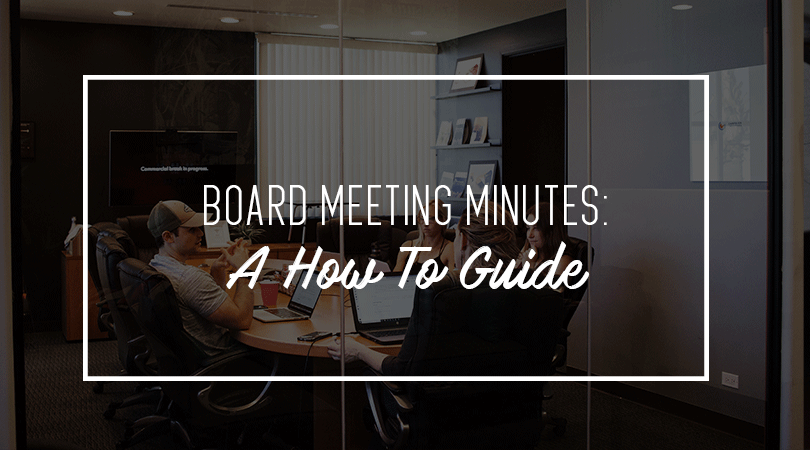Board Meeting Minutes: A How To Guide For Executive Assistants
Ok, meeting minutes may not be your favorite thing, but they can be a lifesaver. Board meetings are a crucial part of most organizations, whether big or small. And despite how it may seem, they actually serve a very critical purpose. They bring together directors and leaders of an organization, and in many cases, individuals who are not direct employees of the organization but were chosen to help lead and direct the corporation.
The purpose of a board meeting is to review past performance, discuss current strategy and revenue pace, and then approve plans of action for future growth of the organization. Consider it a very formal, legal way to make sure companies are doing what they can to grow.
As an executive assistant, you can be VERY important to the success of a board meeting. When managing a board meeting, you can wear many hats depending on who you are supporting and his/her role on the board. Some responsibilities include:
- Putting together board packets
- Organizing location/venue, providing beverages/snacks
- Taking notes during the meeting
- Organizing and disseminating the board minutes
So, what are board minutes and why are they important? They are an official record of action and provide evidence. They serve a historical purpose, yes, but more so a legal purpose. They prove that the Board is adhering to procedures and bylaws. The minutes during a meeting are discoverable in litigation – so it’s crucial to be accurate. No pressure.
Let’s look at some best practices for putting together your best board meeting minutes.
Board Meeting Minutes Tips
As mentioned before, board meeting minutes serve as an official and legal record of the meeting. To make your life easy, we strongly suggest completing these minutes as soon as possible upon adjournment.
Review the Past
If you are new to your role or this responsibility of managing board meeting minutes, it’s always a good idea to see what has happened in the past. This will give you a good sense of whether or not to make some slight modifications to how you manage your board meeting minutes. Take a look at what others have done to take notes. Some thoughts to consider include:
- Is there a template that you can use? If not, check out some examples from Board Effect
- Confirm process with the person who is in charge of managing the meeting – this is usually the President or Board Secretary
Taking Notes During The Meeting
Because board meeting minutes are considered a legal document, you must include the following in your board meeting minutes:
- Date of the meeting
- Time the meeting was called to order
- Names of the meeting participants and absentees
- Corrections and amendments to previous meeting minutes
- Additions to the current agenda
- Whether a quorum is present
- Motions taken or rejected
- Voting-that there was a motion and second, and the outcome of the vote
- Actions taken or agreed to be taken
- Next steps
- Items to be held over
- New business
- Open discussion or public participation
- Next meeting date and time
- Time of adjournment
Now, you may be thinking, how am I supposed to get all of this information – especially when my executives go so fast!?! You are in luck, because there are a few tricks that can help you be more efficient.
As we mentioned before, having a notes template will really make the job easier.
Don’t be afraid to have your board members sign in when they arrive, and be sure to have the board leader conduct roll call so you can check everyone off the list. It’s smart to have a list of board members in your hand so you can easily check them off as they are marked present.
Keep your notes clean, concise and easy to read.
Don’t be afraid to ask clarifying questions – you are the one writing the minutes, so you need to understand.
The board meeting is over. Phew! Now what?
Writing the Actual Minutes
Here comes the fun part… Trying to understand your notes. Fear not, you can do it! Use the Board Meeting Minutes template that you have approved from your stakeholders. This will help keep your meeting minutes organized.
Another great tip: Write the minutes as soon as possible so the details are fresh in your mind. It will save you the trouble of trying to re-read your chicken scratch or shorthand, especially when you need to be sure to document important information, such as quorums.
Finally, be sure to keep it short and sweet. In other words, keep the information basic and simple so you can avoid any potential legal implications. The simpler, the better.
Wrapping It Up
Usually, a Board Secretary (this could be you as the executive assistant) reviews and submits the board meeting minutes to the board of directors’ leader, who is most likely the President. In many cases, the President or lead official must sign off on the board meeting minutes before they are distributed to other board members. The process of dissemination varies from organization to organization, and there are some great tools to help you manage that, such as BoardEffect. What are you best tips to managing board meeting minutes? We’d love to know! Leave us a comment below.
Leave us a comment below.
Other Resources:



